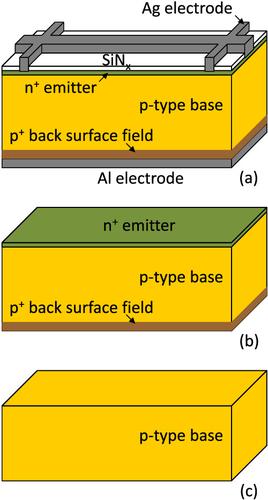当前位置:
X-MOL 学术
›
Prog. Photovoltaics
›
论文详情
Our official English website, www.x-mol.net, welcomes your
feedback! (Note: you will need to create a separate account there.)
Major challenges and opportunities in silicon solar module recycling
Progress in Photovoltaics ( IF 8.0 ) Pub Date : 2020-07-22 , DOI: 10.1002/pip.3316 Meng Tao 1 , Vasilis Fthenakis 2 , Burcak Ebin 3 , Britt‐Marie Steenari 3 , Evelyn Butler 4 , Parikhit Sinha 5 , Richard Corkish 6 , Karsten Wambach 7 , Ethan S. Simon 8
Progress in Photovoltaics ( IF 8.0 ) Pub Date : 2020-07-22 , DOI: 10.1002/pip.3316 Meng Tao 1 , Vasilis Fthenakis 2 , Burcak Ebin 3 , Britt‐Marie Steenari 3 , Evelyn Butler 4 , Parikhit Sinha 5 , Richard Corkish 6 , Karsten Wambach 7 , Ethan S. Simon 8
Affiliation

|
This article examines some of the basic questions about silicon module recycling: (1) What can be recovered from silicon modules? (2) What recycling technologies are needed? (3) What are the potential revenues for different recycling scenarios? And (4) what are the major challenges for different recycling scenarios? Three recycling scenarios are considered: module reuse, component extraction, and material extraction. Recycling process sequences for different scenarios are outlined. The discussions conclude that module reuse generates the highest revenue with the fewest processing steps, while material extraction leads to the lowest revenue with the most processing steps. It is suggested that gentle and clean separation of silicon solar cells from the glass pane is a critical technology for silicon module recycling. It is also argued that two low‐concentration metals must be recovered from silicon modules: silver as a scarce material and lead as a toxic material. Their recovery requires chemical methods, while bulky materials including glass cullet, aluminum frame, and copper wiring can be recovered with physical methods. The silicon in the cells can be extracted with different qualities: ferro‐silicon, metallurgical‐grade silicon, or solar‐grade silicon, with a higher revenue and more complicated recycling process for purer silicon. Markets outside the solar industry for the recovered silicon should be explored. The biggest challenge for module reuse is to find a large and sustained market for hundreds of gigawatts peak of decommissioned modules a year, and the biggest challenge for component extraction is the many different module and cell structures on the market and cell efficiency variability. For all the three scenarios, the cost of collecting and processing waste modules is a common challenge.
中文翻译:

硅太阳能电池组件回收中的主要挑战和机遇
本文研究了有关硅模块回收的一些基本问题:(1)可以从硅模块中回收什么?(2)需要什么回收技术?(3)不同回收方案的潜在收入是多少?(4)不同回收方案的主要挑战是什么?考虑了三种回收方案:模块重复使用,组件提取和材料提取。概述了不同方案的回收过程顺序。讨论得出的结论是,模块重用以最少的处理步骤产生最高的收益,而材料提取则以最多的处理步骤产生最低的收益。建议将硅太阳能电池与玻璃板温和清洁地分离是回收硅模块的一项关键技术。也有人认为,必须从硅模块中回收两种低浓度金属:作为稀有材料的银和作为有毒材料的铅。它们的回收需要化学方法,而包括玻璃碎玻璃,铝框和铜线的笨重材料可以通过物理方法回收。电池中的硅可以采用不同的质量进行提取:铁硅,冶金级硅或太阳能级硅,具有更高的收入和更纯净的硅回收工艺。应该探索太阳能行业以外的回收硅市场。重复使用模块的最大挑战是,要找到一个庞大且持续的市场,每年要有数百吉瓦的退役模块峰值,组分提取的最大挑战是市场上许多不同的模块和电池结构以及电池效率差异。对于所有这三种情况,收集和处理废物模块的成本都是一个共同的挑战。
更新日期:2020-09-15
中文翻译:

硅太阳能电池组件回收中的主要挑战和机遇
本文研究了有关硅模块回收的一些基本问题:(1)可以从硅模块中回收什么?(2)需要什么回收技术?(3)不同回收方案的潜在收入是多少?(4)不同回收方案的主要挑战是什么?考虑了三种回收方案:模块重复使用,组件提取和材料提取。概述了不同方案的回收过程顺序。讨论得出的结论是,模块重用以最少的处理步骤产生最高的收益,而材料提取则以最多的处理步骤产生最低的收益。建议将硅太阳能电池与玻璃板温和清洁地分离是回收硅模块的一项关键技术。也有人认为,必须从硅模块中回收两种低浓度金属:作为稀有材料的银和作为有毒材料的铅。它们的回收需要化学方法,而包括玻璃碎玻璃,铝框和铜线的笨重材料可以通过物理方法回收。电池中的硅可以采用不同的质量进行提取:铁硅,冶金级硅或太阳能级硅,具有更高的收入和更纯净的硅回收工艺。应该探索太阳能行业以外的回收硅市场。重复使用模块的最大挑战是,要找到一个庞大且持续的市场,每年要有数百吉瓦的退役模块峰值,组分提取的最大挑战是市场上许多不同的模块和电池结构以及电池效率差异。对于所有这三种情况,收集和处理废物模块的成本都是一个共同的挑战。











































 京公网安备 11010802027423号
京公网安备 11010802027423号